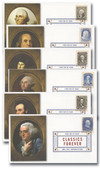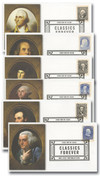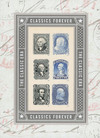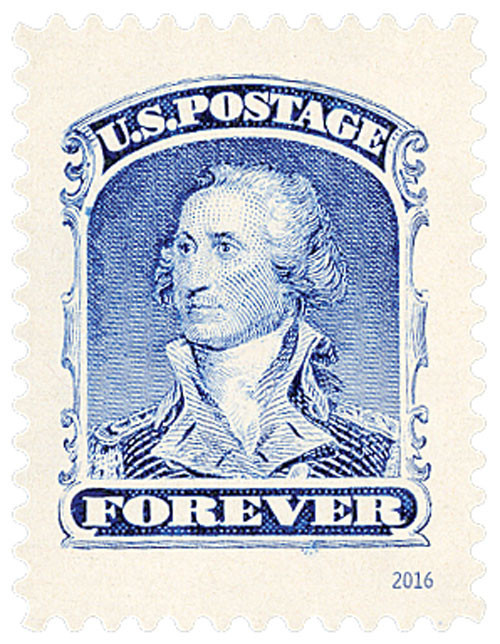
2016 First-Class Forever Stamp,Classics Forever
# 5079 - 2016 First-Class Forever Stamp - Classics Forever
$12.50 - $39.95
U.S. #5079
2016 47c Classics Forever
People have been sending correspondence and parcels for thousands of years. But only in the past 200 years has the advent of postage revolutionized how we handle the mail. Prepaid postage in the United States, and in many parts of the world, is a rather recent development in the grand scheme of things.
When the United States was first being colonized, mail would arrive from overseas by ship. The intended recipient received notice of a waiting parcel via an advertisement in the local paper. Usually, one had to pay to retrieve the item, so it is not hard to imagine that many packages may have gone unclaimed under this system.
While colonists cared more about hearing from their old countries overseas, the British government realized the need for an efficient mail system within the colonies for official correspondence. A handful of independent mail routes existed as early as 1639, but the Crown decided to start its own. In 1693, the Internal Colonial Postal Union began service. It was a financial disaster. When Britain tried to tax mail documents to make the venture more lucrative, tensions increased, igniting the first stages of the American Revolution.
As the colonies moved toward independence, the first U.S. Post Office was created, with Benjamin Franklin as postmaster. Still, recipients paid the mail fee when it was delivered, not before. When Britain introduced prepaid postage in 1840, the U.S. paid close attention to its success. By mid-1847, the U.S. had its own prepaid postage system with standardized rates. Soon, national postage stamps with the likenesses of the Founding Fathers could be found on mail going from coast to coast.
Value: 47c
Issued: June 1, 2016
First Day City: New York, NY
Type of Stamp: First Class Mail
Printed by: Banknote Corporation of America
Method: Intaglio, Offset
Self-Adhesive
Quantity Printed: 18,000,000
Issued to celebrate the history of U.S. postage stamps and as a tribute to all stamp collectors, this souvenir sheet features six new versions of highly acclaimed mid-1800s classics. The stamp sheet was designed by art director Antonio Alcala.
U.S. #5079
2016 47c Classics Forever
People have been sending correspondence and parcels for thousands of years. But only in the past 200 years has the advent of postage revolutionized how we handle the mail. Prepaid postage in the United States, and in many parts of the world, is a rather recent development in the grand scheme of things.
When the United States was first being colonized, mail would arrive from overseas by ship. The intended recipient received notice of a waiting parcel via an advertisement in the local paper. Usually, one had to pay to retrieve the item, so it is not hard to imagine that many packages may have gone unclaimed under this system.
While colonists cared more about hearing from their old countries overseas, the British government realized the need for an efficient mail system within the colonies for official correspondence. A handful of independent mail routes existed as early as 1639, but the Crown decided to start its own. In 1693, the Internal Colonial Postal Union began service. It was a financial disaster. When Britain tried to tax mail documents to make the venture more lucrative, tensions increased, igniting the first stages of the American Revolution.
As the colonies moved toward independence, the first U.S. Post Office was created, with Benjamin Franklin as postmaster. Still, recipients paid the mail fee when it was delivered, not before. When Britain introduced prepaid postage in 1840, the U.S. paid close attention to its success. By mid-1847, the U.S. had its own prepaid postage system with standardized rates. Soon, national postage stamps with the likenesses of the Founding Fathers could be found on mail going from coast to coast.
Value: 47c
Issued: June 1, 2016
First Day City: New York, NY
Type of Stamp: First Class Mail
Printed by: Banknote Corporation of America
Method: Intaglio, Offset
Self-Adhesive
Quantity Printed: 18,000,000
Issued to celebrate the history of U.S. postage stamps and as a tribute to all stamp collectors, this souvenir sheet features six new versions of highly acclaimed mid-1800s classics. The stamp sheet was designed by art director Antonio Alcala.











